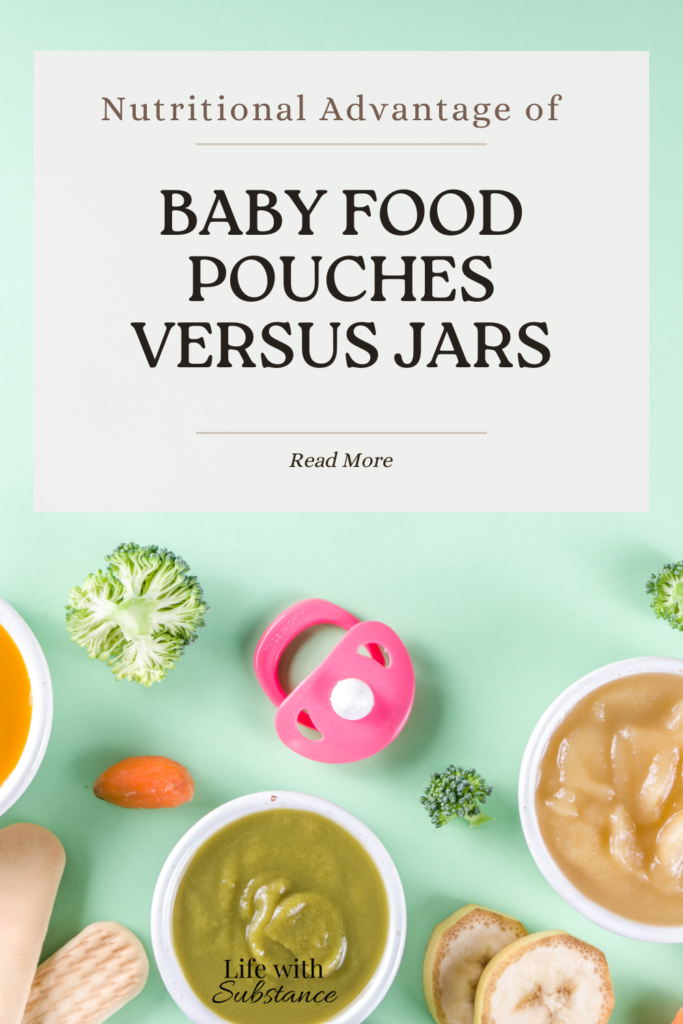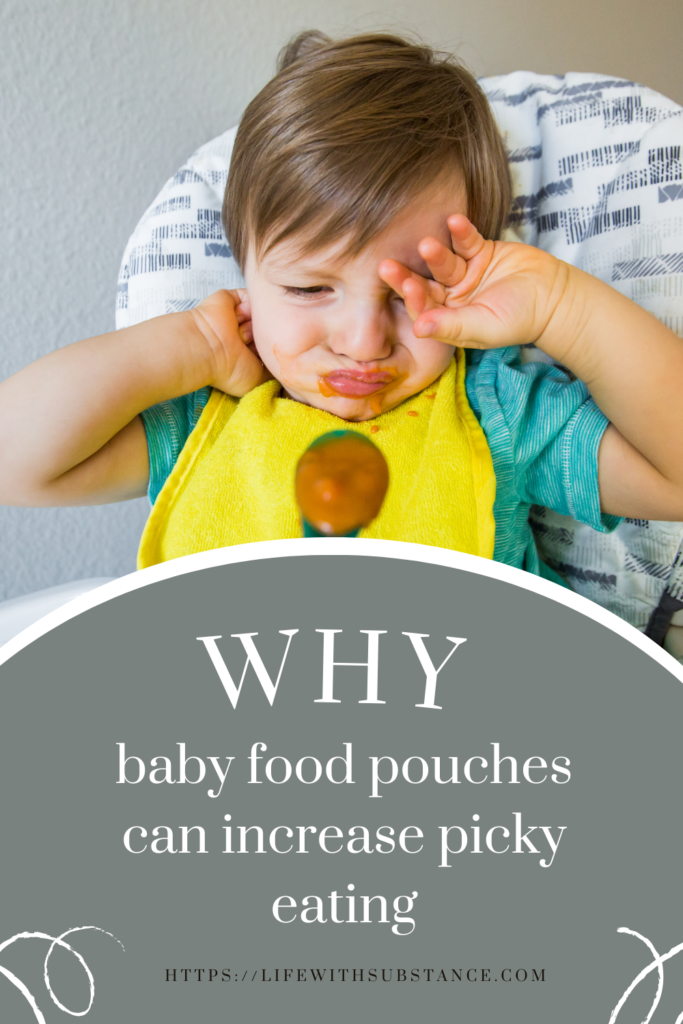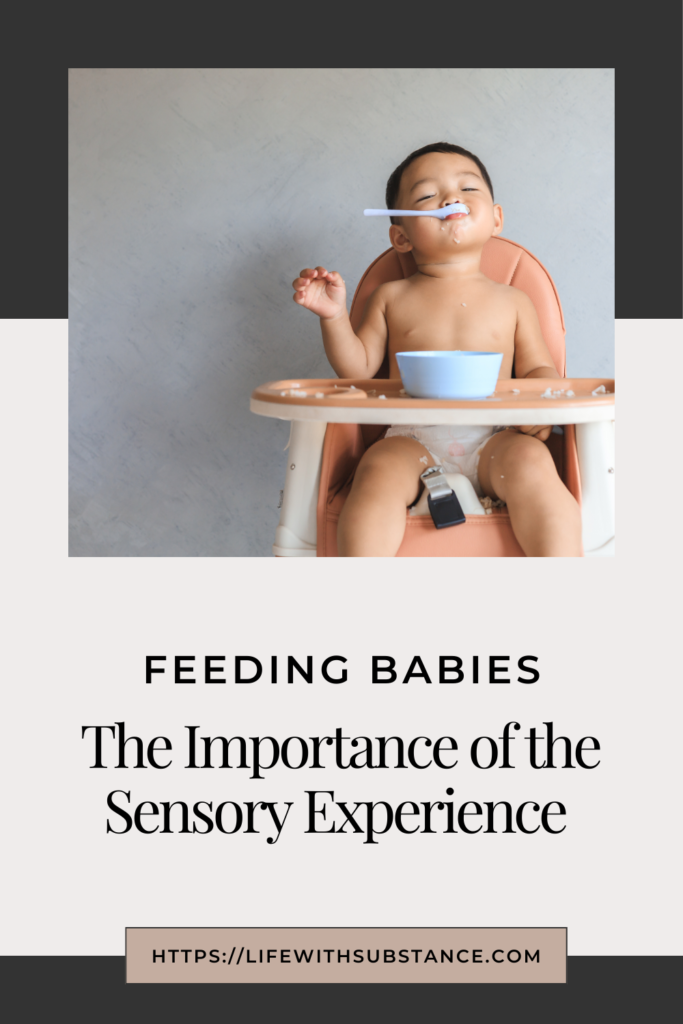This post may contain affiliate links. If you shop from one of our links, we may earn a commission.
Baby food pouches have become a popular choice for many families, offering a convenient way to feed babies and toddlers on the go. As parents, our lives are increasingly busy between carpooling, sporting events, and school activities, which makes the need for meal and snack simplicity an even bigger priority. When it comes to feeding our little ones, we are always on the lookout for convenient and nutritious options. But are these pouches really as healthy as they seem?
Pros of Baby Food Pouches
As a new parent, I really wanted my child to eat a wide variety of fruits and vegetables. Like most infants, she was an adventurous eater trying a wide variety of flavors and textures. And then she turned 1 and decided she had an opinion about what she wanted on her plate. Of course, this made me concerned that all she would ever eat again were Goldfish, Puffs, and noodles. Out of desperation to get more fruits and veggies into her diet I turned to baby food pouches in attempts to get a variety of foods into her diet.
Looking back, I made a lot of feeding mistakes with my first child. I think that’s part of being a parent. But now that I know better, I can do better. Now don’t get me wrong, I’m not saying you’re a bad parent if you feed your child baby food pouches. Even I still buy them on occasion for a quick and convenient option. But I know that we don’t have to be dependent on them as a sole way to get in fruits and vegetables. Of course, they aren’t all bad, so let’s start off by discussing the benefits of these mixed bags.

Convenience and Health on the Go
Navigating the bustling life of parenthood, baby food pouches emerge as a beacon of convenience and nutritional promise. These ingenious packets simplify mealtime during those hectic days filled with errands, travel, or unexpected delays. Their design is thoughtfully tailored for on-the-go consumption; no spoon required, no refrigeration needed, and absolutely no mess – a dream come true for any parent juggling the myriad tasks of daily life.
What’s more, these pouches aren’t just about convenience. Many brands have stepped up their game by sourcing whole, organic ingredients, presenting an appealing alternative to the traditional, often heat-processed options found in baby food jars. This commitment to quality ingredients ensures that your little ones receive the nourishment they need without the added preservatives or artificial flavors that parents are keen to avoid.
As we strive to balance the demands of our schedules with the nutritional needs of our children, baby food pouches stand out as a practical solution that doesn’t compromise on health. They epitomize the modern parent’s ally in delivering wholesome, tasty nutrition in a form that fits seamlessly into our dynamic lives, making them a valuable tool in our parenting arsenals.
Broadening Palates with Diverse Flavors
One of the shining virtues of baby food pouches is their capability to introduce our little ones to a kaleidoscope of tastes and ingredients, some of which might not make their way into the regular dining routine. From the sweetness of mangoes to the earthy tones of beets, these pouches craftily combine fruits and vegetables in pairings that may be less common in the family meal plan, thereby gently nudging young palates towards a more adventurous approach to eating. This early exposure is key in cultivating a willingness to embrace new foods.
The Nutritional Advantage Over Traditional Jars
In the landscape of baby nutrition, baby food pouches carve out a significant edge over their jarred counterparts. This leap in nutritional value stems from their minimal processing and the conscientious selection of ingredients. Unlike the traditional jars that often undergo extensive heat processing to ensure shelf stability— a process that can diminish the natural nutrients and flavors of foods— pouches frequently employ gentler methods that better preserve the important nutrients of fresh fruits and vegetables. This means the vibrant colors, natural sweetness, and essential nutrients are more intact in pouches, offering your child a closer experience to eating whole foods.

Mess-Free
I don’t feel like I need to elaborate on this one. Pouch purees make eating on the go so simple without the added mess, which is always a win!
Helpful Option for “Problem Feeding”
Eating just isn’t that simple for some kids. For example, kids who struggle with ARFID (Avoidant Restrictive Food Intake Disorder), history of tube feeding, or neurocognitive disabilities may need the simplicity of texture while still getting in some nutrition.
Why These Pouch Foods Are “Sometimes” Foods
Trust me, I’m not here to demonize food pouches, but rather, approach them with healthy caution. My job as a pediatric dietitian is to inform parents about the pros and cons of various feeding methods. I always like to take the perspective of feeding both as a mom and a dietitian to help parents choose the best option for their kids. And while there are many benefits to these squeezable pouches, here are some reasons why I consider them “sometimes” foods.
The Risk of Cultivating Picky Eaters
A noteworthy concern with the reliance on baby food pouches is their potential role in fostering selective eating behaviors among children. The uniform texture and consistency of pureed food in pouches deprive young ones of the necessary exposure to a variety of food textures and forms that solid foods offer. This lack of diversity can make the transition to more textured table foods a challenging milestone, potentially leading to resistance against trying new or different foods.
By sidestepping the crucial phase of tactile and experiential learning with food, children might develop a narrower preference palette, showing reluctance towards anything outside their familiar pureed favorites. It’s crucial to gradually introduce a range of advanced textures and whole foods alongside pouches to mitigate this risk, ensuring a smoother progression towards a balanced and accepting approach to eating as your children grow.

Missing Out on Fiber and the Sugar Pitfall
While baby food pouches are undeniably handy for on-the-go nourishment, they’re not without their nutritional shortcomings, notably in the realms of fiber content and sugar levels. Whole foods, such as fruits, vegetables, and whole grains, naturally contain fiber which is neceeary for a healthy digestive system. However, the pureeing process often used in creating these pouches can strip away significant amounts of this vital nutrient. This reduction in fiber could potentially affect your child’s digestion and bowel regularity, emphasizing the importance of incorporating fiber-rich solid foods into their diet as they grow.
Equally concerning is the sugar content in some baby food pouches. Despite the convenience and nutritional advantages they offer, it’s important to read the labels for the presence of added sugars. While naturally occurring sugars in fruits and vegetables are a part of a balanced diet, added sugars are unnecessary and could foster a preference for overly sweet foods. You should aim for pouches that prioritize the natural sweetness of their ingredients, devoid of any additional sweeteners, to ensure your little ones enjoy the health benefits without the sugar overload.
Beyond Taste: The Importance of Sensory Experience
Navigating the early stages of feeding introduces more than just the challenge of incorporating a variety of nutritious foods; it’s also about fostering a rich sensory relationship with food. Baby food pouches, while convenient, sidestep the vital sensory experiences of seeing, touching, and smelling food directly. These experiences are not just ancillary to eating; they are central to developing a deep appreciation and understanding of food.
Engaging all the senses in the eating process helps young children form connections between different foods and their flavors, textures, and appearances. This sensory exploration is essential for building a healthy and adventurous approach to eating, laying the groundwork for positive food-related decisions in the future.
When little ones are limited to consuming their meals from pouches, they miss out on the tactile experience of squishing a ripe avocado between their fingers or the visual of a brightly colored fruit salad. This kind of sensory play and exploration is important for encouraging curiosity and openness to try new foods.
As a mom, I completely understand the benefit of a mess-free snack, however, touching, seeing, and smelling their food is so important in helping them learn to expand their diet. It’s through these early, hands-on experiences that children learn to appreciate the beauty and diversity of whole foods, setting them on a path toward a lifelong enjoyment and exploration of healthy eating.

The Tendency Towards Lazy Eating Habits
The convenience of baby food pouches, while a good thing for busy parents, inadvertently introduces a potential pitfall into the feeding routine: the development of passive eating behaviors. Your baby is born with the sucking reflex and is a pro at this by the time you begin to introduce solids around 4 to 6 months of age. By offering baby food pouches, you aren’t challenging your little one to learn the skill of chewing, strengthening their tongue, and closing their lips around a spoon.
This ease of consumption—where little effort is required to enjoy a meal—might discourage active engagement with food. Active eating is a learning experience that involves chewing, manipulating various textures, and responding to one’s own hunger and fullness signals. It’s a crucial aspect of eating that helps children become attuned to their bodies’ needs and preferences. In contrast, the straightforward squeeze-and-swallow method associated with pouches could lead to a less mindful approach to meals, where the act of eating becomes automatic rather than intentional.
To counteract this, integrating opportunities for hands-on eating experiences is key. Inviting children to interact with a variety of textures and forms—be it through soft finger foods at family meals or participating in simple meal preparations—encourages a more active and engaged relationship with food. This not only helps in developing healthy eating habits but also in fostering a sense of independence and curiosity about food, enriching their eating experience far beyond the convenience of a pouch.
Limits Flavor Exposure
We have five universally accepted tastes such as salt, sweet, sour, bitter, and umami. Many baby food pouches include one taste: sweet. Babies are already geared to enjoy sweet things as a result of breast milk and amniotic fluids being sweet. By introducing new foods and textures, your child will learn to enjoy a variety of different tastes.
The Risk of Overeating
Consuming baby food pouches is less interactive and labor-intensive than eating solids, making it easy to overconsume and ignore fullness cues. It takes very minimal effort for little ones to squeeze a pouch and ingest the whole thing without ever stopping to recognize if they are satisfied. The inability to listen to hunger and fullness cues can lead to overconsumption and excess weight gain over time. Our goal as parents should be to help raise intuitive eaters who can identify when their tummy feels content.
Pouch Pointers
Offering baby food pouches every once in awhile is fine. Just don’t rely on them as your child’s main source of nutrition. If you want to offer them on occasion, here are a few things to consider:
- Check for mold and the expiration date. As with any food, pouches are susceptible to food-borne illness. Be sure to toss an opened pouch or put it in the fridge if they don’t eat it all.
- Be aware of the portion size. Some pouches are offered in larger sizes, which is often more food than some toddlers need.
- Read labels to avoid too much added sugar.
- Try squirting some of the pouch onto a spoon, toast, in oatmeal or yogurt. This allows them to still enjoy the taste of the pouch while also challenging your child to other tastes and textures.
In Conclusion
Feeding little ones is hard and exhausting. Some parents make homemade baby food while others choose convenience foods. There is no one right way or wrong way to feed your child. However, it is important to be informed and exercise caution in certain areas of feeding. Baby food pouches can be a good option when traveling or needing a quick snack, but for a variety of reasons, aim to keep these as “sometimes” foods to help your child keep expanding their diet and relationship with food.

